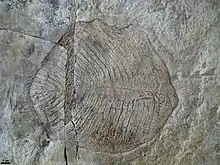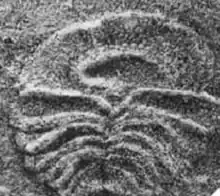| Yorgiidae Temporal range: Ediacaran | |
|---|---|
 | |
| Scientific classification | |
| Domain: | Eukaryota |
| Kingdom: | Animalia |
| Phylum: | †Proarticulata |
| Class: | †Cephalozoa |
| Family: | †Yorgiidae Ivantsov, 2001 |
| Genera | |
| |
Yorgiidae is an extinct family of cephalozoans, which lived 635 million years ago.[1] They were filter fed.[2]
Description
Like most proarticulates, they present semi-bilateral symmetry. They had a discoid appearance, with the body segmented by isomers.
Distribution
Ediacaran of Russian Federation and South Australia.[1]
Gallery

 Other fossil of Archaeaspinus fedonkini
Other fossil of Archaeaspinus fedonkini Epibaion waggoneri, possible ichnofossil of Yorgia waggoneri
Epibaion waggoneri, possible ichnofossil of Yorgia waggoneri
See also
References
- 1 2 Distribution age in the paleontology database
- ↑ Budd, Graham E.; Jensen, Sören (2017). "The origin of the animals and a 'Savannah' hypothesis for early bilaterian evolution". Biological Reviews. 92 (1): 446–473. doi:10.1111/brv.12239. hdl:10662/8091. ISSN 1469-185X. PMID 26588818. S2CID 39110115.
This article is issued from Wikipedia. The text is licensed under Creative Commons - Attribution - Sharealike. Additional terms may apply for the media files.